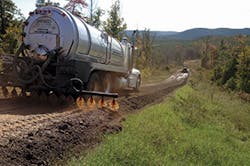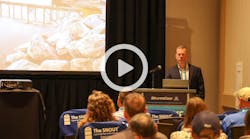Oil and gas companies operating in an exceptional-value or high-quality watershed have to use higher-standard BMPs, known as ABACT (antidegradation best available combination of technologies).
“When they’re in a normal cold-water or warm-water fishery watershed, they have to design for a two-year, 24-hour rain event, whereas when they’re in a high-quality or exceptional-value watershed, they have to design for a five-year, 24-hour rain event with more robust BMPs,” notes Stephen Brokenshire, who serves as environmental group manager for the Bureau of Planning and Program Management, a divsion of the Pennsylvania Department of Environmental Protection’s Office of Oil and Gas Management. “We have higher standards in the high-quality watersheds in Pennsylvania.”
Oil and gas companies operating in an exceptional-value or high-quality watershed have to use higher-standard BMPs, known as ABACT (antidegradation best available combination of technologies).
“When they’re in a normal cold-water or warm-water fishery watershed, they have to design for a two-year, 24-hour rain event, whereas when they’re in a high-quality or exceptional-value watershed, they have to design for a five-year, 24-hour rain event with more robust BMPs,” notes Stephen Brokenshire, who serves as environmental group manager for the Bureau of Planning and Program Management, a divsion of the Pennsylvania Department of Environmental Protection’s Office of Oil and Gas Management. “We have higher standards in the high-quality watersheds in Pennsylvania.”
[text_ad]
Additionally, larger projects require post-construction stormwater BMPs to restore the water quality and runoff rates to pre-existing conditions, notes Vincent Yantko, mineral resources program specialist for the bureau.
“They have to maintain the same runoff coefficient,” adds Brokenshire. “After a certain amount of time when they’re done drilling, the clock begins that they have to restore that site and scale the pad back, because those pads may be there for the next 25 to 50 years, especially if they’re going to start drilling other target formations. As a result, they are required to put post-construction stormwater management BMPs in, and they’re obligated to maintain them for as long as that well pad is there.”
The comprehensive Erosion and Sediment Pollution Control Manual, which was updated in March 2012, outlines all the BMPs the state’s engineers have reviewed and approved.
“We don’t require it, but we encourage people to use our E&S control manual so that the BMPs are already there for them,” says Brokenshire. “If we know they’re using them, then we’re confident in their performance. It’s in our regulations that it is recommended when they’re developing an erosion and sediment control plan, they use the manual.”
The state allows for the use of emerging technologies and a combination of technologies, “but they have to prove their effectiveness,” says Brokenshire. “Normally they follow the manual because they know there usually won’t be any questions.”
Contractors are permitted to use water and natural wood polymer for dust control on the unpaved access roads to the drilling sites. The state often receives complaints of mud tracking out onto the main roads from the pipeline areas.
“We typically require them to get some equipment in there to brush the dirt and mud that tracks off the site and take it back up on to the site, not just brush it off to the side of the road,” says Yantko.
The most common problems the Pennsylvania DEP employees see on oil and gas sites are improper erosion and sediment control BMP installation and maintenance.
“I won’t say it’s a routine violation, but it’s one that we do see quite often,” says Yantko. “Some subcontractors are not well versed on properly installing the E&S BMPs. It’s amazing how complicated silt fence can be to some people.
It actually has to be trenched into the ground.
“I call what they do sometimes ‘ring around the rosie’—which means they just put a line of silt fence in a complete circle around the project and they don’t understand the concept that it has to be parallel to the terrain.”
Failure to install E&S BMPs properly can create a problem that’s more significant than the one the BMP is supposed to protect against, points out Yantko.
“Instead of controlling the sediment runoff from the site, you can actually funnel the water and cause a bigger erosion problem by not installing them properly,” he says.
[text_ad use_post='27664']
“One of the most important criteria in the Chapter 102 regulations for these BMPs is a self-regulating program, where these operators are supposed to inspect these controls weekly and after each stormwater event,” says Brokenshire. “If that’s done and these inspections are done properly, everything should run smoothly.”
As for the conventional well sites on less than 5 acres, they are required only to have an erosion and sediment plan when they disturb more than 5,000 square feet. Typically, the sites are under an acre.
“Sometimes there’s practically a zero footprint if they’re a really good well driller who can drill a well with very little earth disturbance,” says Brokenshire. “They don’t have to get a full blown ESCGP-2 permit, only a well permit. They are still required to get a Chapter 105 general permit if they’re encroaching within 50 feet of water or going to cross it.
“An encroachment permit has its own erosion and sediment control plan requirements,” he adds. “A very sensitive area, the water or wetland, gets its own E&S plan and the permit itself has its own criteria for the permitted activity. It’s like a permit within a permit for those operators conducting earthmoving activities near water.”
Additionally, larger projects require post-construction stormwater BMPs to restore the water quality and runoff rates to pre-existing conditions, notes Vincent Yantko, mineral resources program specialist for the bureau.
“They have to maintain the same runoff coefficient,” adds Brokenshire. “After a certain amount of time when they’re done drilling, the clock begins that they have to restore that site and scale the pad back, because those pads may be there for the next 25 to 50 years, especially if they’re going to start drilling other target formations. As a result, they are required to put post-construction stormwater management BMPs in, and they’re obligated to maintain them for as long as that well pad is there.”
The comprehensive Erosion and Sediment Pollution Control Manual, which was updated in March 2012, outlines all the BMPs the state’s engineers have reviewed and approved.
“We don’t require it, but we encourage people to use our E&S control manual so that the BMPs are already there for them,” says Brokenshire. “If we know they’re using them, then we’re confident in their performance. It’s in our regulations that it is recommended when they’re developing an erosion and sediment control plan, they use the manual.”
The state allows for the use of emerging technologies and a combination of technologies, “but they have to prove their effectiveness,” says Brokenshire. “Normally they follow the manual because they know there usually won’t be any questions.”
Contractors are permitted to use water and natural wood polymer for dust control on the unpaved access roads to the drilling sites. The state often receives complaints of mud tracking out onto the main roads from the pipeline areas.
“We typically require them to get some equipment in there to brush the dirt and mud that tracks off the site and take it back up on to the site, not just brush it off to the side of the road,” says Yantko.
The most common problems the Pennsylvania DEP employees see on oil and gas sites are improper erosion and sediment control BMP installation and maintenance.
“I won’t say it’s a routine violation, but it’s one that we do see quite often,” says Yantko. “Some subcontractors are not well versed on properly installing the E&S BMPs. It’s amazing how complicated silt fence can be to some people.
It actually has to be trenched into the ground.
“I call what they do sometimes ‘ring around the rosie’—which means they just put a line of silt fence in a complete circle around the project and they don’t understand the concept that it has to be parallel to the terrain.”
Failure to install E&S BMPs properly can create a problem that’s more significant than the one the BMP is supposed to protect against, points out Yantko.
“Instead of controlling the sediment runoff from the site, you can actually funnel the water and cause a bigger erosion problem by not installing them properly,” he says.
“One of the most important criteria in the Chapter 102 regulations for these BMPs is a self-regulating program, where these operators are supposed to inspect these controls weekly and after each stormwater event,” says Brokenshire. “If that’s done and these inspections are done properly, everything should run smoothly.”
As for the conventional well sites on less than 5 acres, they are required only to have an erosion and sediment plan when they disturb more than 5,000 square feet. Typically, the sites are under an acre.
“Sometimes there’s practically a zero footprint if they’re a really good well driller who can drill a well with very little earth disturbance,” says Brokenshire. “They don’t have to get a full blown ESCGP-2 permit, only a well permit. They are still required to get a Chapter 105 general permit if they’re encroaching within 50 feet of water or going to cross it.
“An encroachment permit has its own erosion and sediment control plan requirements,” he adds. “A very sensitive area, the water or wetland, gets its own E&S plan and the permit itself has its own criteria for the permitted activity. It’s like a permit within a permit for those operators conducting earthmoving activities near water.”


